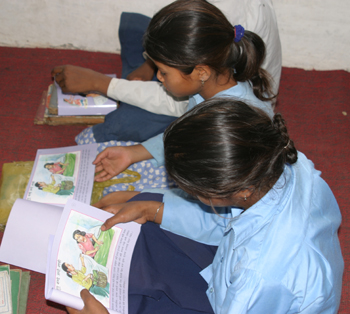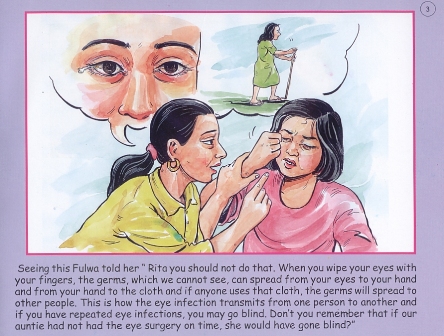Click here to view the gallery of storybooks

Carter Center Photo
Nepalese students learn about Fulwa, a young girl who helps her aunt seek treatment for blinding trachoma.
Overview
Most school-based trachoma programs use storybooks in trachoma lessons. Students learn about the SAFE strategy through the characters in the stories. Usually these stories feature school children applying their trachoma lessons to everyday situations such as encouraging a family member to get trichiasis surgery or build a latrine.
These characters can be popular among students, and their stories help them remember their lessons on the SAFE strategy. Many characters are so popular with students that educators will create new stories for other lessons with the same characters. In order to ensure a wider audience and better comprehension, most trachoma programs develop storybooks in both the country's official language and in regional local languages.
|
Designing Storybooks
For example, this book from Nepal tells the story of a young boy who learns about trachoma from his grandmother. |
|
 |
The dialogue in this page teaches a lesson. Fulwa (at left) tells her cousin Rita (at right) not to touch her eyes with her hands because she will transmit her eye infection to others. The main lesson focuses on the effects of Rita's actions, which will ultimately lead to blindness. |
|
Many storybooks feature students as health educators to their families and friends. This encourages them to assume this role in real life. The story is followed by simple exercises and activities to bridge the lessons from the story to everyday life. |
|
|
Pre-Testing Storybooks |
|
 |
Nepalese students read about Kalu, a boy who teaches his family the importance of face-washing. Carter Center Photo |
View the Health Education Materials Tutorial to learn more about the design and development of health education materials.
View Storybooks (Click blue link to view full documents in PDF)
 |
 |
 |
 |
| Toilet Story Book | Rabbit Story Book | Stay Clean and Prevent Blindness Part I | Stay Clean and Prevent Blindness Part II |
| Morocco Arabic |
Morocco Arabic |
Nepal English |
Nepal English |
 |
 |
 |
 |
| Stay Clean and Prevent Blindness Part III | Trachoma Story Book | Vaincre le trachome au Burkina | Moulaye et le trachome |
| Nepal English |
Nepal Nepali |
Burkina French |
Mali French |
 |
 |
 |
 |
| Amharic Story Book | Huong Dan Truyen | Trachoma Prevention Book | Le Talibe |
| Ethiopia Amharic |
Vietnam Vietnamese |
Ghana English |
Niger French |
 |
 |
 |
 |
| Pendant la Recreation | Au reveil | La Fete Annuelle Chez les Animaux | La Petit Sani |
| Niger French |
Niger French |
Niger French |
Niger French |
Please sign up below for important news about the work of The Carter Center and special event invitations.